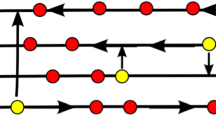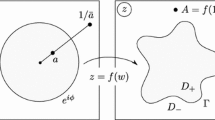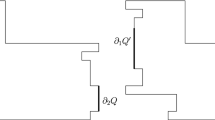Abstract
We study the evolution of grain boundary networks by the mean-curvature flow under the restriction that the networks are Voronoi diagrams for a set of points. For such evolution we prove a rigorous universal upper bound on the coarsening rate. The rate agrees with the rate predicted for the evolution by mean-curvature flow of the general grain boundary networks, namely that the typical grain area grows linearly in time. We perform a numerical simulation which provides evidence that the dynamics achieves the rate of coarsening that agrees with the upper bound in terms of scaling.





Similar content being viewed by others
References
Anderson, M.P., Grest, G.S., Srolovitz, D.J.: Computer simulation of normal grain growth in three dimensions. Philos. Mag. B 59, 293–329 (1989)
Anderson, M.P., Srolovitz, D.J., Grest, G.S., Sahni, P.S.: Computer simulation of grain growth—I. Kinetics. Acta Metall. 32, 783–791 (1984)
Barmak, K., Emelianenko, M., Golovaty, D., Kinderlehrer, D., Ta’asan, S.: Towards a statistical theory of texture evolution in polycrystals. SIAM J. Sci. Comput. 30, 3150–3169 (2008)
Beck, P.: Interface migration in recrystallization. In: Brick, R. (ed.) Metal Interfaces, pp. 208–247. American Society for Metals, Cleveland (1952)
Bellettini, G., Chermisi, M., Novaga, M.: Crystalline curvature flow of planar networks. Interfaces Free Bound. 8, 481–521 (2006)
Cahn, J.W.: Stability, microstructural evolution, grain growth, and coarsening in a two-dimensional two-phase microstructure. Acta Metall. Mater. 39, 2189–2199 (1991)
Dai, S.: On the shortening rate of collections of plane convex curves by the area-preserving mean curvature flow. SIAM J. Math. Anal. 42, 323–333 (2010)
Elsey, M., Esedo\(\bar{\rm g}\)lu, S., Smereka, P.: Diffusion generated motion for grain growth in two and three dimensions. J. Comput. Phys. 228, 8015–8033 (2009)
Elsey, M., Esedo\(\bar{\rm g}\)lu, S., Smereka, P.: Large scale simulation of normal grain growth via diffusion generated motion. Proc. R. Soc. Lond. A 467, 381–401 (2011)
Fradkov, V.E.: A theoretical investigation of two-dimensional grain growth in the ‘gas’ approximation. Philos. Mag. Lett. 58, 271–275 (1988)
Glazier, J.A., Weaire, D.: The kinetics of cellular patterns. J. Phys. Condens. Matter 4, 1867–1894 (1992)
Gottstein, G., Shvindlerman, L.: Grain Boundary Migration in Metals: Thermodynamics, Kinetics, Applications. Materials Science & Technology, 2nd edn. Taylor & Francis, Boca Raton (2011)
Henseler, R., Niethammer, B., Otto, F.: A reduced model for simulating grain growth. In: Free Boundary Problems (Trento 2002), Vol. 147 of Int. Ser. Numer. Math. Birkhäuser, Basel 2004, 177–187 (2004)
Herring, C.: Surface tension as a motivation for sintering. In: Kingston, W. (ed.) The Physics of Powder Metallurgy, pp. 143–179. McGraw-Hill, New York (1951)
Herring, C.: The use of classical macroscopic concepts in surface-energy problems. In: Gomer, R., Smith, C. (eds.) Structure and Properties of Solid Surfaces, pp. 5–72. University of Chicago Press, Chicago (1953)
Herrmann, M., Laurençot, P., Niethammer, B.: Self-similar solutions to a kinetic model for grain growth. J. Nonlinear Sci. 22, 399–427 (2012)
Joyce, D.: On manifolds with corners. In: Janeczko, S., Li, J., Phong, D. (eds.) Advances in Geometric Analysis, pp. 225–258. International Press, Boston (2012)
Kinderlehrer, D., Liu, C.: Evolution of grain boundaries. Math. Models Methods Appl. Sci. 11, 713–729 (2001)
Kinderlehrer, D., Livshits, I., Ta’asan, S.: A variational approach to modeling and simulation of grain growth. SIAM J. Sci. Comput. 28, 1694–1715 (2006)
Klain, D.A., Rota, G.C.: Introduction to geometric probability. Lezioni Lincee. [Lincee Lectures]. Cambridge University Press, Cambridge (1997)
Kohn, R.V., Otto, F.: Upper bounds on coarsening rates. Commun. Math. Phys. 229, 375–395 (2002)
Lindenbergh, R., van der Kallen W., Siersma, D.: Configuration spaces and limits of Voronoi diagrams. In: Geometry and Topology of Caustics–CAUSTICS ’02, vol. 62 of Banach Center Publ., Polish Acad. Sci., Warsaw, pp. 183–195 (2004)
R. C. Lindenbergh: Limits of Voronoi diagrams, Rijksuniversiteit te Utrecht, Utrecht, 2002. Dissertation, Universiteit Utrecht, Utrecht, 2002
MacPherson, R.D., Srolovitz, D.J.: The von Neumann relation generalized to coarsening of three-dimensional microstructures. Nature 446, 1053–1055 (2007)
Michor, P.W., Mumford, D.: Vanishing geodesic distance on spaces on spaces of submanifolds and diffeomorphisms. Doc. Math. 10, 217–245 (2005)
Mugnai, L., Seis, C.: On the coarsening rates for attachment-limited kinetics. SIAM J. Math. Anal. 45, 324–344 (2013)
Mullins, W.W.: Two-dimensional motion of idealized grain boundaries. J. Appl. Phys. 27, 900–904 (1956)
Otto, F., Rump, T., Slepčev, D.: Coarsening rates for a droplet model: rigorous upper bounds. SIAM J. Math. Anal. 38, 503–529 (2006)
Slepčev, D.: Coarsening in nonlocal interfacial systems. SIAM J. Math. Anal. 40, 1029–1048 (2008)
von Neumann, J.: Written discussion. In: Herring, C. (ed.) Metal interfaces, pp. 108–110. American Society for Metals, Cleveland (1952)
Wakai, F., Enomoto, N., Ogawa, H.: Three-dimensional microstructural evolution in ideal grain growth—general statistics. Acta Mater. 48, 1297–1311 (2000)
Acknowledgments
ME was supported in part by a Rackham Predoctoral Fellowship. DS is grateful to NSF (Grant DMS-0908415) and FCT (Grant UTA_CMU/MAT/0007/2009). The research was also supported by NSF PIRE Grant OISE-0967140. The authors are thankful to the Center for Nonlinear Analysis (NSF Grant DMS-0635983) for its support.
Author information
Authors and Affiliations
Corresponding author
Additional information
Communicated by Felix Otto.
Appendix: Derivation of Coordinates for \(v_{ijk}\)
Appendix: Derivation of Coordinates for \(v_{ijk}\)
Equation (10) may be derived as follows: The vertex \(v_{ijk}\) must satisfy
from which we subtract \(v_{ijk} \cdot v_{ijk}\) to obtain
which can be combined to obtain
and
In matrix form, this can be expressed as
We compute
(10) arises by left-multiplying (23) by (24), observing that \(a \cdot b^\perp = -b \cdot a^\perp \), and collecting like terms.
Rights and permissions
About this article
Cite this article
Elsey, M., Slepčev, D. Mean-Curvature Flow of Voronoi Diagrams. J Nonlinear Sci 25, 59–85 (2015). https://doi.org/10.1007/s00332-014-9221-x
Received:
Accepted:
Published:
Issue Date:
DOI: https://doi.org/10.1007/s00332-014-9221-x




